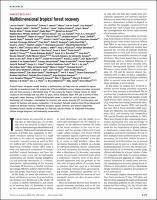| dc.contributor.author | Pooter, Lourens | |
| dc.contributor.author | Craven, Dylan | |
| dc.contributor.author | Jakovac, Catarina C | |
| dc.contributor.author | van der Sander, Masha T | |
| dc.contributor.author | Amissah, Lucy | |
| dc.contributor.author | Bongers, Frans | |
| dc.contributor.author | Chazdon, Robin L | |
| dc.contributor.author | Farrior, Caroline E | |
| dc.contributor.author | Kambach, Stephan | |
| dc.contributor.author | Meave, Jorge A | |
| dc.contributor.author | Muñoz, Rodrigo | |
| dc.contributor.author | Norden, Natalia | |
| dc.contributor.author | Rüger, Nadja | |
| dc.contributor.author | van Breugel, Michiel | |
| dc.contributor.author | Almeyda Zambrano, Angélica María | |
| dc.contributor.author | Amani, Bienvenu | |
| dc.contributor.author | Andrade, José Luis | |
| dc.contributor.author | Brancalion, Pedro H. S. | |
| dc.contributor.author | Broadbent, Eben N | |
| dc.contributor.author | Foresta, Hubert de | |
| dc.contributor.author | Dent, Daisy H | |
| dc.contributor.author | Derroire, Géraldine | |
| dc.contributor.author | DeWalt, Saara J | |
| dc.contributor.author | Dupuy, Juan M. | |
| dc.contributor.author | Durán, Sandra M | |
| dc.contributor.author | Fantini, Alfredo C | |
| dc.contributor.author | Finegan, Bryan | |
| dc.contributor.author | 63 autores más | |
| dc.date.accessioned | 2021-12-14T20:31:39Z | |
| dc.date.available | 2021-12-14T20:31:39Z | |
| dc.date.issued | 2021-12 | |
| dc.identifier.uri | https://repositorio.catie.ac.cr/handle/11554/11467 | |
| dc.description.abstract | Tropical forests disappear rapidly because of deforestation, yet they have the potential to regrow
naturally on abandoned lands. We analyze how 12 forest attributes recover during secondary succession
and how their recovery is interrelated using 77 sites across the tropics. Tropical forests are highly
resilient to low-intensity land use; after 20 years, forest attributes attain 78% (33 to 100%) of their
old-growth values. Recovery to 90% of old-growth values is fastest for soil (<1 decade) and plant
functioning (<2.5 decades), intermediate for structure and species diversity (2.5 to 6 decades), and
slowest for biomass and species composition (>12 decades). Network analysis shows three independent
clusters of attribute recovery, related to structure, species diversity, and species composition.
Secondary forests should be embraced as a low-cost, natural solution for ecosystem restoration,
climate change mitigation, and biodiversity conservation. | en |
| dc.format.extent | 7 páginas | en |
| dc.language.iso | en | en |
| dc.publisher | AAAS, Washington, DC (USA) | en |
| dc.relation.ispartof | Science, 374 (6573) | |
| dc.relation.uri | https://www.science.org/doi/10.1126/science.abh3629 | en |
| dc.subject | REFORESTACIÓN | en |
| dc.subject | RESTAURACIÓN | en |
| dc.subject | ECOSISTEMAS FORESTALES | en |
| dc.subject | MITIGACIÓN DEL CAMBIO CLIMÁTICO | en |
| dc.subject | ALMACENAMIENTO | en |
| dc.subject | BIODIVERSIDAD | en |
| dc.subject | SUCESIÓN SECUNDARIA | en |
| dc.subject | BOSQUE TROPICAL | en |
| dc.subject | ESPECIES | en |
| dc.subject | ANÁLISIS | en |
| dc.subject.other | Sede Central | en |
| dc.title | Multidimensional tropical forest recovery | en |
| dc.type | Artículo | en |
| dc.creator.id | Bryan Finegan https://orcid.org/
0000-0002-7035-255X | |
| dc.identifier.status | openAccess | en |
| dc.subject.sdg | ODS 13 - Acción por el clima | en |


